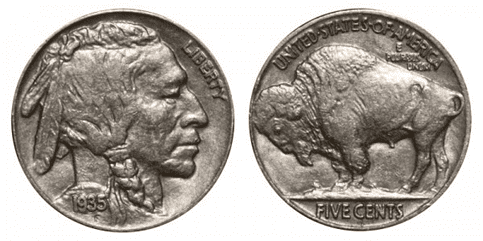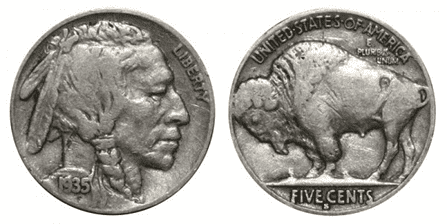Buffalo nickels are one of America’s most popular coins from the twentieth century. With an American Indian on the obverse and a bison on the reverse, they’re true Americana.
James Earle Fraser created the Buffalo nickel, which was originally struck in 1913. In 1938, the Buffalo nickel was replaced by the Jefferson nickel. These nickels had an impact on everyone in the United States. Even the homeless were affected, as they used to carve their own designs on Buffalo nickels and sell them as art. Meals, commodities, and services were exchanged for Hobo nickels.
The majority of Buffalo nickels are available in circulated grades at prices that many coin collectors can afford. There’s also the collectability aspect to these works, in addition to the romance. These coins were widely circulated throughout the 1950s and 1960s, and a few were still in circulation in the 1970s. The history, lore, and relative accessibility of assembling a complete Buffalo nickel collection appeal to both older and younger coin collectors.
Composition
Despite their silver-tone, and the fact that many coins from this era did have some silver content, the Buffalo nickel is comprised of 75% copper with 25% nickel cladding (giving the nickel its silver tone). This means the coin has very little intrinsic metal value and weighs around 0.17637 ounces (5 g).
1935 Buffalo Nickel Series
1) 1935 Buffalo Nickel No Mint Mark
Year: 1935
Face Value: $0.5c
Composition: 75% copper with 25% nickel cladding
Total Weight: 5g
Diameter: 21.2 mm
Thickness: 1.95 mm
Edge: Plain
Minted in: Philadelphia
Quantity Minted: 58,264,000

2) 1935 D-Buffalo Nickel
Year: 1935
Face Value: $0.5c
Composition: 75% copper with 25% nickel cladding
Total Weight: 5g
Diameter: 21.2 mm
Thickness: 1.95 mm
Edge: Plain
Minted in: Denver
Quantity Minted: 12,092,000

3) 1935 S-Buffalo Nickel
Year: 1935
Face Value: $0.5c
Composition: 75% copper with 25% nickel cladding
Total Weight: 5g
Diameter: 21.2 mm
Thickness: 1.95 mm
Edge: Plain
Minted in: San Francisco
Quantity Minted: 10,300,000

List of Errors
Doubled die Reverse

One of the most well-known mint faults in the series is the 1935 Buffalo nickel doubled die reverse. When the master hub multiplied the design component and transferred it to the leading die, this happened.
Doubling is regarded as a rarity that can cost a lot of money, as it is with other mistake coins. Only a few 1935 DDR Buffalo nickels are known to have been produced. The value of circulated coins will range from $42 to $1,667. However, specimens in immaculate condition will cost $5,462 or even $25,300 for the best-preserved examples.
How Much Is A 1935 Buffalo Nickel Worth?
Listed below are the average values for 1935 Buffalo Nickels. As you can see the value of the coin varies heavily dependent on grade. Please note, that this table doesn’t indicate the value of any error coins, as this type of coin is assessed on a coin-to-coin basis, so any generalization wouldn’t be accurate.
1935 Buffalo nickel value |
|||
| Quality | 1935 (P) | 1935 S | 1935 D |
| Good | $0.7 to $0.8 | $0.7 to $0.8 | $0.7 to $0.8 |
| Very good | $0.9 to $1.3 | $0.9 to $1.3 | $0.9 to $1.3 |
| Fine | $1 to $1.6 | $1.1 to $1.6 | $2.1 to $3.2 |
| Very fine | $1.5 to $2 | $1.9 to $2.5 | $5.4 to $13 |
| Extra fine | $2.6 to $4.9 | $2.6 to $11.3 | $20.2 to $35.6 |
| AU | $7.4 to $21 | $22.3 to $43.7 | $48.6 to $75 |
| MS 60 | $23 to $27.5 | $50 to $60 | $74 to $89 |
| MS 61 | $24.3 to $29 | $54 to $65 | $81 to $97 |
| MS 62 | $31 to $37.2 | $58 to $70 | $81 to $97 |
| MS 63 | $37.8 to $45.4 | $74 to $89 | $94 to $113 |
| MS 64 | $55 to $66 | $88 to $105 | $122 to $140 |
| MS 65 | $115 to $133 | $182 to $218 | $300 to $344 |
| MS 66 | $195 to $224 | $338 to $389 | $715 to $822 |
| MS 67 | $819 to $1,090 | $2,380 to $2,880 | $8,120 to $11,200 |
Table courtesy of GreySheet
How Does The Grading System Work?
The Sheldon Scale is used by numismatists to provide a numerical value to coins. The Sheldon Scale goes from poor (P-1) to perfect mint state (P-1) (MS-70). Coins were originally evaluated using words to reflect their condition (Good, Fair, Excellent, Etc.). Unfortunately, coin collectors and dealers had different ideas about what each of these terms represent.
Professional numismatists joined together in the 1970s and established CoinGrading standards. These numismatists now assign grades at key places on the seventy-point scale, using the most regularly utilized numeric points in conjunction with the original adjective grade. The following are the most common coin grades:
-
-
- (P-1) Poor – Indistinguishable and probably damaged; if used, must have a date and mintmark; otherwise, rather battered.
- (FR-2) Fair – Nearly smooth, but without the damage that a coin graded Poor often possesses. The coin must have enough detail to be identified.
- (G-4) Fair – Inscriptions have merged into the rims in some areas, and important elements have been mostly erased.
- (VG-8) Very Good- A little weathered, but all of the primary design elements are visible, albeit faintly. There is little if any, central detail left.
- (F-12) Good – The item is very worn, yet the wear is even, and the overall design details stand out clearly. Rims are almost completely isolated from the field.
- (VF-20) Very Fine – Moderately weathered, with some finer features still visible. The motto or all letters of LIBERTY are readable. Both sides of the coin have entire rims that are separated from the field.
- (EF-40) Extremely Fine – Gently used; all gadgets are visible, and the most important ones are bold. The finer details are bold and clear, however, light wear may be seen.
- (AU-50) Uncirculated – Slight evidence of wear on the coin’s design’s high points; may have contact marks; eye appeal should be adequate.
- (AU-58) Uncirculated Choice – Slight traces of wear, no severe contact marks, almost full mint shine, and great eye appeal.
- (MS-60) Mint State Basal – Strictly uncirculated; no indication of wear on the coin’s highest points, but an unsightly coin with reduced luster, visible contact marks, hairlines, and other flaws.
- (MS-63) Mint State Acceptable – Uncirculated, but with contact scratches and nicks, little reduced shine, but otherwise appealing appearance. The strike is weak to average.
- (MS-65) Mint State Choice – Uncirculated with great mint shine, very little contact blemishes, and exceptional eye appeal. The strike is unusually severe.
- (MS-68) Mint State Premium Quality – Uncirculated with superb luster, no obvious contact marks to the naked eye, and exceptional eye appeal. The strike is quick and appealing.
- (MS-69) Almost Perfect Mint State – Uncirculated with perfect brilliance, a sharp and appealing strike, and extremely good eye appeal. A near-perfect coin with minor imperfections in the planchet, strike, and contact markings (seen only under 8x magnification).
- (MS-70) Mint State Perfect – Under 8x magnification, there are no tiny imperfections discernible; the strike is crisp, and the coin is perfectly centered on a beautiful planchet. Rarely seen on a coin, this coin is bright and whole, with original luster and exceptional eye appeal.
-
Where To Buy Or Sell 1935 Buffalo Nickels?
As it is an older coin, you’re far less likely to come across a Buffalo Nickel in your pocket change; although it’s not unheard of! While options such as pawnbrokers, estate sales, and antique malls make great options for buying and selling antique coins, these options aren’t always accessible to everyone.
When selling your 1935 Buffalo Nickels, consider the following:
- CoinsForSale.com Only 5% to sell. No listing fee.
- Heritage Auctions 10% fee.
- eBay Has a mass audience but costs 12.35% + $.030 fee, plus listing fees.
- Apmex Well known. But won’t pay until after you’ve sent the coin
- Modern Coin Mart Won’t pay you until after you’ve sent the coin
Many of the above options also offer buying options, so take your time to have a look and compare the offerings of a variety of retailers. To avoid counterfeit coins make sure that the coin has been graded by a recognized expert service such as the Professional Coin Grading Service (PCGS) or the Numismatic Guaranty Corporation (NGC).
FAQs
Where is the mint mark on a 1935 Buffalo nickel?
The mint mark on a 1935 Buffalo nickel is found on the reverse side of the coin below the word ‘Five Cents’. If the coin doesn’t have a mint mark it was minted in Philadelphia.
Who is on the 1935 Buffalo nickel?
The portrait on the Buffalo Nickel is thought to be a composite of three different Native Americans: Chief Iron Tail of the Oglala Lakota, Chief Two Moons of the Cheyenne, and Chief John Big Tree of the Kiowa. The Buffalo Nickel’s creator, James Earle Fraser, always said that the model for the buffalo found on the reverse of the coin was Black Diamond, a massive bison from the Bronx Zoo.
Where is the date on a Buffalo nickel?
The date on the Buffalo nickel is found on the shoulder of the Native American chief on the observe side of the coin.
How much is a 1935 gold Buffalo nickel worth?
The American gold Buffalo coin is the first 24-carat bullion coin produced by the United States Mint. When it was first introduced in 2006, it was hailed as a great alternative to the 22 carat Eagles by both investors and collectors. Investors seeking the purest certified US gold coins have been interested in the Gold Buffalo coins. Prices of these coins can start at hundred of dollars up to around $2,000.
